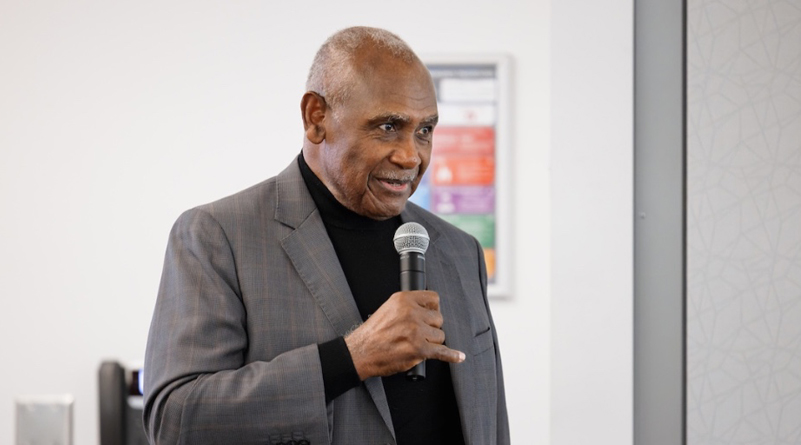Harvey Gantt Tells Central Piedmont: If You Believe In It, You Can Achieve It
Former Charlotte Mayor Harvey Gantt visited Central Piedmont’s Parr Center on March 20 and delivered a lecture on his background as a civil rights pioneer, architectural innovator, and influential politician.
“If you want to do something, you’ve got the capacity to do it,” said Gantt, the first African American student to enroll at Clemson University in 1963. “You might not go through the same types of struggles that I did, but that does not diminish the struggle you may be going through. If you believe in it, you can achieve it. You need to stay determined, and you can do well.”
Gantt spoke for an hour to an audience of Central Piedmont students, primarily in the architectural technology program, and answered questions about his life and career following the event.
Gantt’s story began in fifth grade, when a teacher noticed him sketching and drawing during class. Fearful that he was going to be admonished for not paying attention, the teacher instead encouraged him to continue his drawing and had him help design materials for the classroom bulletin board.
While in high school, an English teacher and guidance counselor both encouraged Gantt’s pursuit of architecture. At the time, Gantt said, less than one percent of architects in the country were African American, but that did not daunt him.
So off he went to Iowa State University, where he excelled in the classroom, but not in the frigid winter environment. His eyes wandered back to his home state of South Carolina and Clemson University, which continually denied his application to attend – not because of his academic record, but because of his race.
Undeterred, a legal battle ensued, and Gantt eventually earned the right to attend Clemson – then one of the top architecture programs in the country – and graduated in 1965. Gantt later earned a Master of City Planning from Massachusetts Institute of Technology (MIT) in 1971 and moved to Charlotte to begin his professional career.
He co-founded Gantt Huberman Architects and surrounded himself with a diverse staff – noting the same type of diversity he saw in the lecture hall full of Central Piedmont students.
“We wanted our firm to be different,” he said. “Our firm needed to look like the people who founded it. We intentionally went out to find people who wanted to work in that kind of environment. There were not that many African American architects at that time, so we had to go out and find them. We tried to meld a culture where everyone was important, and contributions were made by everyone.”
The firm went on to develop some of the city’s most iconic landmarks, including the Charlotte Transportation Center, TransAmerica Square, ImaginOn, Friendship Missionary Baptist Church, and the Johnson C. Smith University Science Center. Gantt shared stories with the students about how those designs came into play.
“[It was so] enriching, this whole experience, to make a difference in public life, and make a lasting difference in the buildings we design for so many people,” he said.
Gantt’s background in urban planning led him to pursue a career in politics, first serving on city council in 1975 before being elected mayor in 1983. He was the first African American mayor in city history and was in that role until 1987.
During the question-and-answer session, Gantt left some parting words of wisdom for the students in attendance.
“You will know when you want to do something in life that fits with who you are,” he said. “Something that allows you to be centered, that allows you to feel like you made a contribution. Whatever your struggle is, it can also be an opportunity to learn.”

